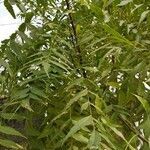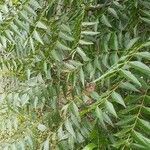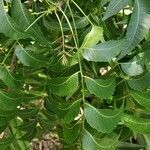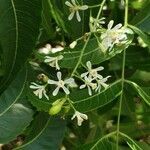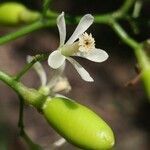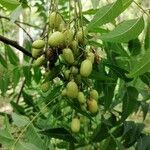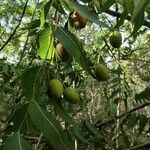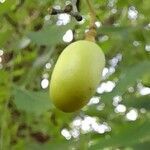| Therapeutic use
|
Abdominal pain (bark), Amenorrhea (bark), Anorexia (bark), Anthelmintics (bark), Anti-bacterial agents (bark), Anticonvulsants (bark), Antiemetics (bark), Antifungal agents (bark), Anti-infective agents, local (bark), Antinematodal agents (bark), Antineoplastic agents (bark), Antiparasitic agents (bark), Antipruritics (bark), Antiviral agents (bark), Appetite stimulants (bark), Astringents (bark), Blister (bark), Bronchitis (bark), Common cold (bark), Contraceptive agents (bark), Cough (bark), Demulcents (bark), Diabetes mellitus (bark), Diuretics (bark), Dyspepsia (bark), Earache (bark), Eczema (bark), Expectorants (bark), Fatigue (bark), Fever (bark), Filariasis (bark), Furunculosis (bark), Gingivitis (bark), Hematologic diseases (bark), Hemorrhage (bark), Hypoglycemic agents (bark), Hypolipidemic agents (bark), Inflammation (bark), Insecticides (bark), Intestinal diseases, parasitic (bark), Leprosy (bark), Liver diseases (bark), Low back pain (bark), Malaria (bark), Measles (bark), Menstruation-inducing agents (bark), Molluscacides (bark), Neoplasms (bark), Pain (bark), Pectoralis muscles (bark), Periodontitis (bark), Pruritus (bark), General tonic for rejuvenation (bark), Scorpion stings (bark), Skin care (bark), Skin diseases (bark), Smallpox (bark), Snake bites (bark), Spasm (bark), Splenomegaly (bark), Syphilis (bark), Thirst (bark), Tuberculosis, lymph node (bark), Ulcer (bark), Urinary incontinence (bark), Urination disorders (bark), Vitiligo (bark), Vomiting (bark), Wound healing (bark), Wounds and injuries (bark), Antiperiodic (bark), Allergens (flower), Anthelmintics (flower), Anti-bacterial agents (flower), Anti-infective agents, local (flower), Antinematodal agents (flower), Antirheumatic agents (flower), Appetite stimulants (flower), Asthenia (flower), Cathartics (flower), Diabetes mellitus (flower), Dyspepsia (flower), Eye diseases (flower), Graves ophthalmopathy (flower), Hypolipidemic agents (flower), Insecticides (flower), Intestinal diseases, parasitic (flower), Jaundice (flower), Leprosy (flower), Pain (flower), General tonic for rejuvenation (flower), Skin care (flower), Abdominal pain (fruit), Anthelmintics (fruit), Antinematodal agents (fruit), Antirheumatic agents (fruit), Astringents (fruit), Capillary permeability (fruit), Cathartics (fruit), Diarrhea (fruit), Emollients (fruit), Endophthalmitis (fruit), Hemorrhage (fruit), Hemorrhoids (fruit), Insecticides (fruit), Leprosy (fruit), Pain (fruit), Parasympatholytics (fruit), General tonic for rejuvenation (fruit), Skin diseases (fruit), Stomach diseases (fruit), Ulcer (fruit), Vomiting (fruit), Antiperiodic (fruit), Acaricide (leaf), Abdominal pain (leaf), Abortifacient agents (leaf), Abscess (leaf), Adrenergic antagonists (leaf), Analgesics (leaf), Anthelmintics (leaf), Anti-arrhythmia agents (leaf), Anti-bacterial agents (leaf), Antifungal agents (leaf), Anti-infective agents (leaf), Anti-infective agents, local (leaf), Anti-inflammatory agents (leaf), Antinematodal agents (leaf), Antineoplastic agents (leaf), Antiparasitic agents (leaf), Antipruritics (leaf), Antipyretics (leaf), Antirheumatic agents (leaf), Antiviral agents (leaf), Appetite stimulants (leaf), Ascariasis (leaf), Astringents (leaf), Capillary permeability (leaf), Conjunctivitis (leaf), Contraceptive agents (leaf), Demulcents (leaf), Diabetes mellitus (leaf), Diarrhea (leaf), Diuretics (leaf), Dyspepsia (leaf), Eczema (leaf), Endophthalmitis (leaf), Eye diseases (leaf), Fever (leaf), Furunculosis (leaf), Galactogogues (leaf), Gastrointestinal hemorrhage (leaf), Gingivitis (leaf), Graves ophthalmopathy (leaf), Hematologic diseases (leaf), Hemorrhoids (leaf), Histamine antagonists (leaf), Hypersensitivity (leaf), Hypnotics and sedatives (leaf), Hypoglycemia (leaf), Hypolipidemic agents (leaf), Hypotension (leaf), Infection (leaf), Insecticides (leaf), Intestinal diseases, parasitic (leaf), Leprosy (leaf), Liver diseases (leaf), Malaria (leaf), Measles (leaf), Menopause (leaf), Molluscacides (leaf), Nervous system diseases (leaf), Pain (leaf), Parasympatholytics (leaf), Periodontal diseases (leaf), Periodontitis (leaf), Pharyngitis (leaf), Anti-poisoning (leaf), Postnatal care (leaf), Premenstrual syndrome (leaf), Scabies (leaf), Scorpion stings (leaf), Skin care (leaf), Skin diseases (leaf), Smallpox (leaf), Snake bites (leaf), Spermatocidal agents (leaf), Splenomegaly (leaf), Tuberculosis (leaf), Ulcer (leaf), Urination disorders (leaf), Vitiligo (leaf), Vomiting (leaf), Wound healing (leaf), Wounds and injuries (leaf), Antiperiodic (leaf), Antinematodal agents (plant exudate), Common cold (plant exudate), Demulcents (plant exudate), Diarrhea (plant exudate), General tonic for rejuvenation (plant exudate), Scorpion stings (plant exudate), Snake bites (plant exudate), Urologic diseases (plant exudate), Anthelmintics (root), Anti-bacterial agents (root), Antiemetics (root), Antinematodal agents (root), Antineoplastic agents (root), Astringents (root), Hypoglycemic agents (root), General tonic for rejuvenation (root), Skin care (root), Antiperiodic (root), Hair loss (seed), Analgesics (seed), Anthelmintics (seed), Anti-bacterial agents (seed), Antifungal agents (seed), Anti-infective agents (seed), Anti-infective agents, local (seed), Anti-inflammatory agents (seed), Antinematodal agents (seed), Antipyretics (seed), Antirheumatic agents (seed), Antiviral agents (seed), Astringents (seed), Contraceptive agents (seed), Demulcents (seed), Diabetes mellitus (seed), Diuretics (seed), Dystocia (seed), Eczema (seed), Edema (seed), Emollients (seed), Fever (seed), Flatulence (seed), Graves ophthalmopathy (seed), Heart diseases (seed), Hematologic diseases (seed), Hemorrhage (seed), Hemorrhoids (seed), Hemostasis (seed), Hypoglycemic agents (seed), Hypolipidemic agents (seed), Inflammation (seed), Insecticides (seed), Intestinal diseases, parasitic (seed), Leprosy (seed), Malaria (seed), Neoplasms (seed), Prenatal care (seed), Pruritus (seed), Psoriasis (seed), Scorpion stings (seed), Skin diseases (seed), Snake bites (seed), Spermatocidal agents (seed), Toothache (seed), Tuberculosis, lymph node (seed), Tuberculosis, pulmonary (seed), Ulcer (seed), Urinary incontinence (seed), Urologic diseases (seed), Uterine contraction (seed), Wound healing (seed), Wounds and injuries (seed), Yellow fever (seed), Anthelmintics (stem), Antipyretics (stem), Antiviral agents (stem), Asthenia (stem), Asthma (stem), Astringents (stem), Cough (stem), Digestive system diseases (stem), Dyspepsia (stem), Fever (stem), Flatulence (stem), Hematologic diseases (stem), Hemorrhoids (stem), Intestinal diseases, parasitic (stem), Jaundice (stem), Kidney diseases (stem), Malaria (stem), Periodontitis (stem), Scorpion stings (stem), Skin care (stem), Skin diseases (stem), Snake bites (stem), Tooth diseases (stem), Tuberculosis (stem), Urinary bladder diseases (stem), Wound healing (stem), Alterative (unspecified), Anthrax (unspecified), Antiseptic (unspecified), Astringent (unspecified), Bite(Snake) (unspecified), Carbuncle (unspecified), Chancre (unspecified), Cholera (unspecified), Dentifrice (unspecified), Deobstruent (unspecified), Detersive (unspecified), Diarrhea (unspecified), Discutient (unspecified), Emollient (unspecified), Fever (unspecified), Gingivitis (unspecified), Insecticide (unspecified), Intestine (unspecified), Lactation (unspecified), Laxative (unspecified), Malaria (unspecified), Measles (unspecified), Poison (unspecified), Purgative (unspecified), Rheumatism (unspecified), Ringworm (unspecified), Scald (unspecified), Scrofula (unspecified), Smallpox (unspecified), Soap (unspecified), Sore (unspecified), Splenitis (unspecified), Stimulant (unspecified), Stomachic (unspecified), Tonic (unspecified), Toothache (unspecified), Tumor (unspecified), Boil (unspecified), Vermifuge (unspecified), Diabetes (unspecified), Eczema (unspecified), Febrifuge (unspecified), Labor (unspecified), Nausea (unspecified), Pyorrhea (unspecified), Skin (unspecified), Syphilis (unspecified), Tumor(Abdomen) (unspecified), Burn (unspecified), Itch (unspecified), Abscess (unspecified), Hair loss (unspecified), Analgesics (unspecified), Anorexia (unspecified), Anthelmintics (unspecified), Anti-bacterial agents (unspecified), Antifungal agents (unspecified), Anti-HIV agents (unspecified), Anti-infective agents (unspecified), Anti-infective agents, local (unspecified), Anti-inflammatory agents (unspecified), Antinematodal agents (unspecified), Antipyretics (unspecified), Antirheumatic agents (unspecified), Antiviral agents (unspecified), Cathartics (unspecified), Celiac disease (unspecified), Colic (unspecified), Common cold (unspecified), Contraceptive agents (unspecified), Diabetes mellitus (unspecified), Diet, food, and nutrition (unspecified), Ear diseases (unspecified), Fractures, bone (unspecified), Furunculosis (unspecified), Hemorrhoids (unspecified), Insecticides (unspecified), Intestinal diseases, parasitic (unspecified), Lactation disorders (unspecified), Leprosy (unspecified), Lithiasis (unspecified), Liver diseases (unspecified), Lymphadenitis (unspecified), Menstruation-inducing agents (unspecified), Neoplasms (unspecified), Pain (unspecified), Periodontal diseases (unspecified), General tonic for rejuvenation (unspecified), Scabies (unspecified), Scalp dermatoses (unspecified), Skin diseases (unspecified), Spermatocidal agents (unspecified), Splenic diseases (unspecified), Splenomegaly (unspecified), Sprains and strains (unspecified), Tooth diseases (unspecified), Ulcer (unspecified), Urination disorders (unspecified), Urologic diseases (unspecified), Wounds and injuries (unspecified), Antiperiodic (unspecified), Cooling effect on body (unspecified), Anthelmintics (whole plant), Antifungal agents (whole plant), Anti-infective agents (whole plant), Anti-inflammatory agents (whole plant), Antipyretics (whole plant), Antiviral agents (whole plant), Fever (whole plant), Insecticides (whole plant), Jaundice (whole plant), Malaria (whole plant), Measles (whole plant), Scalp dermatoses (whole plant), Skin diseases (whole plant), Smallpox (whole plant), Splenomegaly (whole plant), Syphilis (whole plant), Ulcer (whole plant), Gingivitis (wood), Insect repellents (wood), Periodontitis (wood)
|
